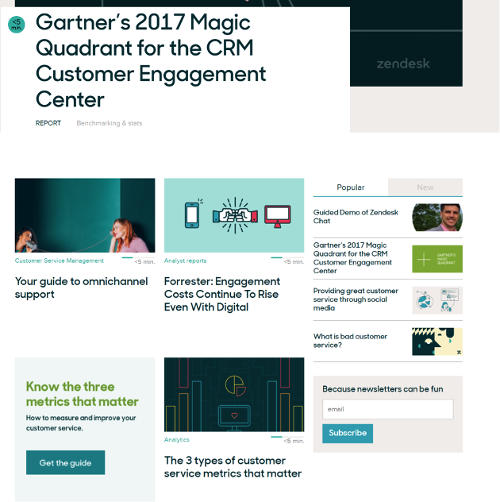Everywhere you look, there are more and more SaaS startups popping up. With easy scalability and high growth rates, it's a business model that works—but your business still has to be marketed well.
Whether you're in HR, music, entertainment, or accountancy, you want to reach more of your target market, engage people effectively, and control churn rates. Here are five ways you can market your subscription business more effectively.
1. Give away a lot for free... but not everything
Giving away something (such as a free trial) is the top subscription marketing tactic.
Why?
It's easy to implement, and, if your product is good, it's guaranteed to work. Your goal is to get people so hooked on your tool or product that they can't picture their life without it.
Here are three tips for offering freebies:
Don't be too generous. Keep something back for paying customers. Whether your trial comes with a usage cap or some restricted features, don't give it all away for free.
Follow up during and after the trial period. Email is easy, chatbots are probably better, and in the B2B market phone calls may work best. Deep customer segmentation will help you create a proper onboarding sequence that addresses any at-risk users during the initial trial period.
Run plenty of ads (social and PPC) directing your audience to your free trial landing page. You can bid on competitor brand names if you're trying to market yourself as the new alternative. To maximize signups, the landing page should be super focused and conversion-driven. A/B-testing can help you design more effective pages.
Big brand Adobe can afford to list all its software as easy downloadables:

Could you create something similar with a free trial and free resource center? "Free" is a big search term and conversion-driver for users, so try to make the most of it.
2. Gather user data for extra features
SaaS marketing should be highly data-driven, with an eye to driving users down the short funnel and sales cycle as quickly as possible. Data helps you pinpoint your next generation of super users so you can allocate support, service, and marketing budget accordingly.
In SaaS marketing, the lines between customer service, support, and marketing are blurred. Early support chats and interactions need to be carefully mined for insights and data, which should be fed back into the marketing and customer lifecycle.
Multichannel customer support is a no-brainer for subscription businesses, which often need comprehensive knowledge centers to help users help themselves.
At the same time, your data shouldn't be used only for triggering emails or retargeting campaigns. Data is one of the most precious assets of a SaaS product manager or marketer, and you should be using it to create new features and improve your products.

Spotify and Netflix are two great examples of SaaS businesses that make the most of user data. Both harvest platform data to create playlists or recommendations, respectively, that have become a legendary, much-loved feature of each service.
3. Create a user community
One of your most important tasks as a subscription marketer is to create a sense of community. If you can get your users fired up and working together, you can transform an empty platform into a vibrant user community.
Here are three ways to help create a community in the early days:
Build an email list. Like, properly. Be very deliberate about it, and use tools that help you make the most of every potential website visitor and interaction.
Create plenty of guides and other content that give away useful information for free. You want to give away things of value to drive organic traffic.
Run a podcast or offer courses that help people make the most of your subscription tool or service. Users and customers will get so much more out of your business if you give them the tools to succeed.
Zendesk has an awesome library of customer support resources like reports, blogs, and charts:

Such an engaging content library helps build brand credibility and engagements over a long period. It's about marketing for the long game, whereas ad campaigns will be more focused on the short term.
Your core messaging should focus entirely on solving user pain points—not bigging up your own brand. Selfish marketing will not help your brand come across as customer-centric.
Outreach tip: When acting as a brand advocate and negotiating PR and press placements, don't talk about your platform or product first. Focus on the industry community, instead, and offer helpful advice on solving business problems. If you can demonstrate to editors and journalists that you've got knowledge that their readers will appreciate, you will be halfway there.
4. Learn from the best
There are some excellent SaaS marketing resources and blogs out there. It's worth following the big names in the marketing space and learning from their tactics and strategies. Read industry reports and mine statistics to set yourself realistic growth goals.
You should also look to big SaaS companies for tips and hints on best-practices. HubSpot does a great job of giving back to the community with useful content, but it also has a pretty aggressive sales pipeline. HubSpot isn't afraid to use LinkedIn Inmail and phone calls to get in touch with people who might be interested in its CRM (especially on the agency side).
On the other end of the scale, Shopify is an online store builder that has had an impressive few years of growth. The secret to its success? Excellent content marketing, good PR relations, and high-grade customer support that's unrivaled in its vertical. By standing out in those key areas, Spotify has managed to make a mark in a competitive niche.
Though you may not be able to compete with big, enterprise-level strategies head-to-head, you should be able analyze what they are doing well—and how you might be able to pinch a customer or two from them!
5. Investigate churn
Churn is bad for subscription companies—but, at the same time, it's entirely normal. Once your marketing strategies start to take off and people get wind of your tool or trial period, your churn rates will increase as your user base diversifies.
Nevertheless, sharp increases to your baseline churn rate need to be carefully examined and addressed. High levels of churn won't make for a solid user base or platform.
* * *
When you're marketing a subscription business, you can apply a lot of the same ground rules of marketing that you would to any business. You need to act on user data, tweak and optimize your funnel, and create a customer community that lives and breathes without your help.




